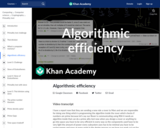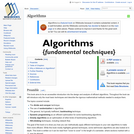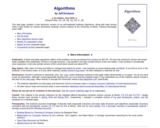
Students work with the concept of equality and balance to solve algebraic equations.
- Subject:
- Mathematics
- Material Type:
- Lesson Plan
- Author:
- Out Teach
- Date Added:
- 07/22/2021

Students work with the concept of equality and balance to solve algebraic equations.

This research-oriented course will focus on algebraic and computational techniques for optimization problems involving polynomial equations and inequalities with particular emphasis on the connections with semidefinite optimization. The course will develop in a parallel fashion several algebraic and numerical approaches to polynomial systems, with a view towards methods that simultaneously incorporate both elements. We will study both the complex and real cases, developing techniques of general applicability, and stressing convexity-based ideas, complexity results, and efficient implementations. Although we will use examples from several engineering areas, particular emphasis will be given to those arising from systems and control applications.

This is a course on the singular homology of topological spaces. Topics include: Singular homology, CW complexes, Homological algebra, Cohomology, and Poincare duality.

This is the second part of the two-course series on algebraic topology. Topics include basic homotopy theory, obstruction theory, classifying spaces, spectral sequences, characteristic classes, and Steenrod operations.

Vengono descritte le regole di base per la manipolazioni di elementi appartanenti a spazi vettoriali.

Introduction do algorithm in k-5 classrooms

This is a research-oriented course on algorithm engineering, which will cover both the theory and practice of algorithms and data structures. Students will learn about models of computation, algorithm design and analysis, and performance engineering of algorithm implementations. We will study the design and implementation of sequential, parallel, cache-efficient, external-memory, and write-efficient algorithms for fundamental problems in computing. Many of the principles of algorithm engineering will be illustrated in the context of parallel algorithms and graph problems.

This course is organized around algorithmic issues that arise in machine learning. Modern machine learning systems are often built on top of algorithms that do not have provable guarantees, and it is the subject of debate when and why they work. In this class, we focus on designing algorithms whose performance we can rigorously analyze for fundamental machine learning problems.

This lesson centers around the How AI Works: Equal Access and Algorithmic Bias video from the How AI Works video series. Watch this video first before exploring the lesson plan.
In this lesson, students will practice cropping images to uncover the bias underlying the Twitter cropping algorithm. Then, students will read and watch a video about the discovery of this biased algorithm. Finally, students will discuss ways to recognize and reduce bias along with analyzing Twitter's response to the allegations of bias in their cropping algorithm.
This lesson can be taught on its own, or as part of a 7-lesson sequence on How AI Works. Duration: 45 minutes

6.890 Algorithmic Lower Bounds: Fun with Hardness Proofs is a class taking a practical approach to proving problems can’t be solved efficiently (in polynomial time and assuming standard complexity-theoretic assumptions like P ≠ NP). The class focuses on reductions and techniques for proving problems are computationally hard for a variety of complexity classes. Along the way, the class will create many interesting gadgets, learn many hardness proof styles, explore the connection between games and computation, survey several important problems and complexity classes, and crush hopes and dreams (for fast optimal solutions).

How can we improve the speed of a (deterministic) primality test? Created by Brit Cruise.

2023 Education Vision "Face to face in-service trainings will be organized for the teaching of algorithmic thinking of classroom teachers in a computer-free environment." The in-service program was opened within the scope of the study, which was initiated in line with the target.

This resource is a video abstract of a research paper created by Research Square on behalf of its authors. It provides a synopsis that's easy to understand, and can be used to introduce the topics it covers to students, researchers, and the general public. The video's transcript is also provided in full, with a portion provided below for preview:
"A new algorithm has successfully mapped part of the brain’s circuitry during shock therapy. For those suffering from severe depression, the approach could make for safer and more effective treatment. For brain research at large, it could lead to better ways of untangling noisy neural data to reveal real connections between different focal regions of the brain. Despite the gruesome picture painted by pop culture, modern shock therapy is a mild treatment option. In fact, over 2 million treatments are administered worldwide every year. Under general anesthesia, patients receive a small amount of current to the brain, triggering a brief seizure. The resulting changes in brain chemistry have been shown to reverse symptoms of mental health conditions like severe depression or bipolar disorder. But the procedure isn’t perfect. One of the most troubling side effects is memory loss, a result of poor targeting. To be effective and safe, induced seizures should be restricted to the pre-frontal cortex..."
The rest of the transcript, along with a link to the research itself, is available on the resource itself.

This book aims to be an accessible introduction into the design and analysis of efficient algorithms. Throughout the book we will introduce only the most basic techniques and describe the rigorous mathematical methods needed to analyze them.
The topics covered include:
The divide and conquer technique.
The use of randomization in algorithms.
The general, but typically inefficient, backtracking technique.
Dynamic programming as an efficient optimization for some backtracking algorithms.
Greedy algorithms as an optimization of other kinds of backtracking algorithms.
Hill-climbing techniques, including network flow.
The goal of the book is to show you how you can methodically apply different techniques to your own algorithms to make them more efficient. While this book mostly highlights general techniques, some well-known algorithms are also looked at in depth. This book is written so it can be read from "cover to cover" in the length of a semester, where sections marked with a * may be skipped.

This resource was created by Jenny Motacek, in collaboration with Dawn DeTurk, Hannah Blomstedt, and Julie Albrecht, as part of ESU2's Integrating the Arts project. This project is a four year initiative focused on integrating arts into the core curriculum through teacher education, practice, and coaching.

This is a textbook for first year Computer Science. Algorithms and Data Structures With Applications to Graphics and Geometry.

This textbook is an introductory coverage of algorithms and data structures with application to graphics and geometry.

This web page contains a free electronic version of my self-published textbook Algorithms, along with other lecture notes I have written for various theoretical computer science classes at the University of Illinois, Urbana-Champaign

This course is offered to undergraduates and addresses several algorithmic challenges in computational biology. The principles of algorithmic design for biological datasets are studied and existing algorithms analyzed for application to real datasets. Topics covered include: biological sequence analysis, gene identification, regulatory motif discovery, genome assembly, genome duplication and rearrangements, evolutionary theory, clustering algorithms, and scale-free networks.

Animation is a compelling and effective form of expression; it engages viewers and makes difficult concepts easier to grasp. Today’s animation industry creates films, special effects, and games with stunning visual detail and quality. This graduate class will investigate the algorithms that make these animations possible: keyframing, inverse kinematics, physical simulation, optimization, optimal control, motion capture, and data-driven methods. Our study will also reveal the shortcomings of these sophisticated tools. The students will propose improvements and explore new methods for computer animation in semester-long research projects. The course should appeal to both students with general interest in computer graphics and students interested in new applications of machine learning, robotics, biomechanics, physics, applied mathematics and scientific computing.